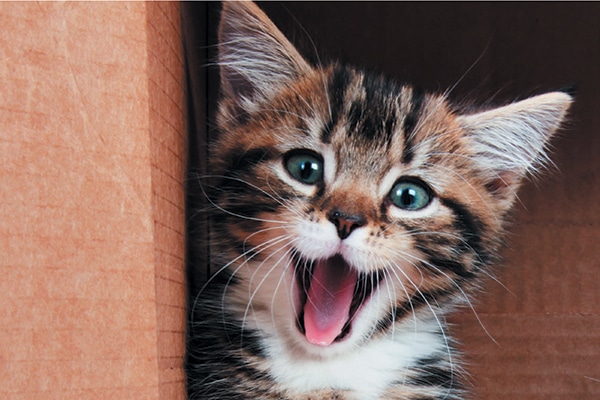Do kittens teethe? Kittens start losing their baby teeth around 9 weeks of age, and from that time until their adult teeth are fully grown in at 5 to 6 months, you can count on lots of chewing action. In fact, like teething babies, teething kittens will bite and chew on anything — including human toes and fingers — to ease the discomfort they feel. This is why kitten teething is a perfect time to teach your kitten to stop chewing on things she shouldn’t. Here are a few tips to help kitten teething and stop misdirected kitten biting.

How do you stop inappropriate cat biting when it comes to kitten teething? Photography © Martin Poole | DigitalVision / Getty Images.
1. Ease That Kitten Teething With a Binkie
Chew toys aren’t just for dogs anymore. A number of manufacturers make toys designed to provide an appropriate target for all that kitten teething. These include cloth toys that can be chilled to ease tender gums, firmer chews that will exercise the jaw muscles and nylon-based toys for kitten teething.
Related: What to Know About Kitten Behaviors
2. Let Your Kitten Bite a Toy Instead
The more your kitten plays with appropriate toys, the less likely she’ll be to chew on you. Your teething kitten needs interactive play because it helps her to work off excess energy and develop her balance and strength. At least two 10-to-15-minute play sessions per day using a teaser toy will give a kitten an appropriate target for her chewing and strengthen the bond between you.
3. Don’t Let Your Kitten Play With Your Hands
When you’re petting your kitten, be sure to keep your hands away from her mouth. The same thing goes for playtime: Never use your fingers as play objects.
4. Practice “Ow!” and Down When Your Kitten Bites Inappropriately
If that kitten teething does lead to a bite, say “Ow!” in a high-pitched but not overly loud voice and put her on the floor. When cats play together and the play gets too rough, the victim will utter a high-pitched cry and this will cause the aggressor to back off. Consistent use of the “Ow” and Down technique will teach your kitten that biting leads to an absence of play or petting.
5. Be Prepared with Chew Toys for Your Kitten
Make sure you keep appropriate chew toys on hand wherever you are. If you’re sitting with your teething kitten and you see her getting in the mood to bite or chew, you can give her the toy and say, “Here, chew this.”
It’s crucial that you consistently and lovingly reinforce the message that only certain things are appropriate for kitten teething, chewing and biting, and people are not among them. The behavior training you do now will set the stage for the rest of your lives together. It’s entirely up to you whether that life includes being a human pincushion.
Tell us: How do you handle kitten teething? How did you teach your kitten not to bite you? Tell us in the comments!
Featured photo: Photography by ©Foonia | Getty Images.
Originally published in 2012.
Read Next: When Do Kittens’ Eyes Change Color?
